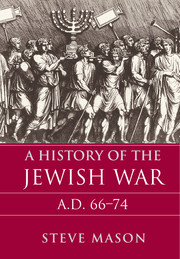Book contents
CONCLUSIONS
Published online by Cambridge University Press: 05 February 2016
Summary
It is time to review our main results. Since I have emphasized the importance of thinking about historical method, I first summarize the method and then the substantive conclusions it has produced.
METHOD
While writing these chapters I have imagined a critical voice objecting: “Your prattling about historical method doesn't make any difference, does it? You have cited passages from Josephus and material remains in support of your reconstruction, choosing your favourites and ignoring others, just as everyone else does!” In case my readers have heard the same voice, or perhaps they own it, I would like to explain in light of the foregoing chapters. A metaphor may help.
We usually approach Josephus as we would a house made of brick and stone. We can see the materials from which the house is constructed. If we are interested in some small part of that structure ‒ in Pontius Pilate, the upper priesthood, the causes of the war ‒ we look at what Josephus has done with that part and suspect that we could do better. In building his house, we believe, he had a skewed perspective and/or unimaginative vision: fealty to the Flavians or some pathetic effort to exculpate his kind from war guilt. But no one doubts that he used excellent materials, and they don't make them like that any more! So our best bet is to dismantle his house and salvage those materials for our building. We can identify good material through a combination of intuition and educated guesswork about its provenance: Is this a brick that he himself made ad hoc, a solid older one, or a piece of excellent stone? To help us decide, we use the principle that whatever does not seem to fit his building design is likely older and not made by him. Even better, not too far from Josephus’ house are piles of loose bricks ‒ fragmentary material remains ‒ that are wonderful for us because they do not belong to any existing structure. They are free for us to use along with the best bits from Josephus as we build a more robust structure.
Having stretched the metaphor to breaking point, I shall leave it there. My implicit criticism is directed at all of us, myself included.
- Type
- Chapter
- Information
- A History of the Jewish WarAD 66–74, pp. 576 - 590Publisher: Cambridge University PressPrint publication year: 2016

